
 |
 |
 |
 |
 |
 |
 |
 |

 "Art is to serve a purpose and allow people to develop their own creative instincts from it. We have become far removed from such ideas. In the old days, art began as a craft; it was used towards a given end. This is not the case today. Take the architect for example, he is a master-builder of yesterday, but he has lost touch with his basic tools: earth, wood, brick, concrete. Things have become too abstract; so abstract that we can no longer relate to them on a practical level." Issam El-Said*
"Art is to serve a purpose and allow people to develop their own creative instincts from it. We have become far removed from such ideas. In the old days, art began as a craft; it was used towards a given end. This is not the case today. Take the architect for example, he is a master-builder of yesterday, but he has lost touch with his basic tools: earth, wood, brick, concrete. Things have become too abstract; so abstract that we can no longer relate to them on a practical level." Issam El-Said*
The untimely death of the Iraqi artist, Issam Sabah Nuri El-Said, in London at the tender age of 49, has deprived the Arab and Islamic world of one of its brilliant icons. His artistic temperament underlined a creative genius which touched all his activities, whether as a printmaker, painter, decorative designer of furniture, lamps, carpets and tiles, architect and etcher. Perhaps the saddest legacy of this Cambridge architecture graduate will be his unfulfilled ambitions and his unfinished work. Mushtak Parker*
 The Wedding*
The Wedding*
Oil on canvas
183x152cm
1967
SOLD
This work was auctioned at Bonhams (London) on 28 April 2005.
It is with immense pride and pleasure we present this unique website featuring a rare collection of artworks by the distinguished late Iraqi artist Issam El-Said as well as an insight into his background, intellect, artistic and scholarly achievements during what was a relatively short life span, where he died in London 1988, at the age of 50.

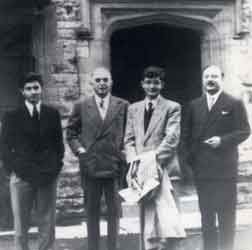 Born in Baghdad 1938, Issam El-Said was the son of Sabah Nuri El-Said (Iraqi) and Esmat Fahmi (Egyptian). His Paternal grandparents were Nuri El-Said Pasha (Iraq's prime minister from 1930-58) and Naima Al-Askari (Iraqi). His Maternal grandparents were Ali Fahmi Pasha (Egyptian) and Nur-Sefa Celik (Turkish). He had one brother; Falah El-Said who married Nahla Al-Askari and had Sabah; then married Dina Maher and had Sima and Zeina. Sadly, Issam El-Said died in London, 1988 at the age of 50. Issam between his grandfather Nuri El-Said and father Sabah El-Said with his brother Falah El-Said, 1956.
Born in Baghdad 1938, Issam El-Said was the son of Sabah Nuri El-Said (Iraqi) and Esmat Fahmi (Egyptian). His Paternal grandparents were Nuri El-Said Pasha (Iraq's prime minister from 1930-58) and Naima Al-Askari (Iraqi). His Maternal grandparents were Ali Fahmi Pasha (Egyptian) and Nur-Sefa Celik (Turkish). He had one brother; Falah El-Said who married Nahla Al-Askari and had Sabah; then married Dina Maher and had Sima and Zeina. Sadly, Issam El-Said died in London, 1988 at the age of 50. Issam between his grandfather Nuri El-Said and father Sabah El-Said with his brother Falah El-Said, 1956.

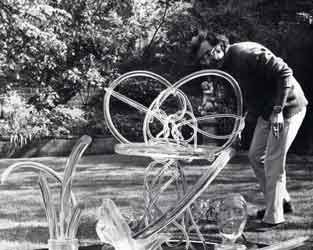 Issam El-Said (1938-88)
Issam El-Said (1938-88)
Achieved a BA Architecture from Corpus Christi College, Cambridge in 1961; studied art at Hammersmith College of Art and Design, London in 1962-4 and prepared for a PhD on the Methodology of Geometric Proportioning in Islamic Architecture at the University of Newcastle-upon-Tyne in 1988, which was sadly not completed due to his untimely death that year. Key extracts from his thesis however were published by the Issam El-Said Foundation in a book entitled Islamic Art and Architecture: The System of Geometric Design,1993. El-Said was the co-author of Geometric Concepts in Islamic Art, published by the World of Islam Festival, London, 1976 and contributed numerous articles on Islamic art and architecture which were published in Europe and the USA.
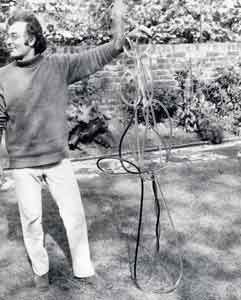 The creative work of Issam El-Said in the form of painting, sculpture, printmaking, calligraphy, design and architectural projects shows his dedication to the expression of the Islamic cultural identity. El-Said’s fascination for geometry – the vocabulary and language of Islamic art - manifested itself in the design concepts for constructing geometric patterns determining a formula used by craftsmen and master builders in Islamic art and architecture, which avoids the use of complicated mathematical calculations. This involvement developed alongside his understanding of the essence, beauty, perfection and harmony found in the Islamic arts and architecture irrespective of the region or era and he delved into theory and practice to reconstruct their elements, all of which endorsed his theory that ‘all Islamic arts were governed by the science of preparations in the realm of metre, rhythm and in the form of interval in music’ as developed by Moslem scholars and draftsmen.
The creative work of Issam El-Said in the form of painting, sculpture, printmaking, calligraphy, design and architectural projects shows his dedication to the expression of the Islamic cultural identity. El-Said’s fascination for geometry – the vocabulary and language of Islamic art - manifested itself in the design concepts for constructing geometric patterns determining a formula used by craftsmen and master builders in Islamic art and architecture, which avoids the use of complicated mathematical calculations. This involvement developed alongside his understanding of the essence, beauty, perfection and harmony found in the Islamic arts and architecture irrespective of the region or era and he delved into theory and practice to reconstruct their elements, all of which endorsed his theory that ‘all Islamic arts were governed by the science of preparations in the realm of metre, rhythm and in the form of interval in music’ as developed by Moslem scholars and draftsmen.
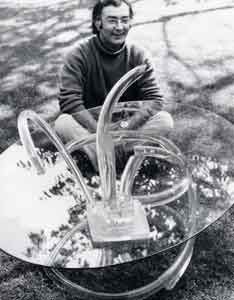 El-Said demonstrated wonderfully, through both his personal life and creative work, that the spiritual values of Islam can be integrated with the practice of art and architecture. The artist’s mother, the late Dr Esmat El-Said said ‘The unforgettable scenery of his country made on him a deep impression which haunted his imagination during his entire life. Not only the bright colours of the sky, the golden rays of the sun, the sparkling stars over the endless horizon of the desert, but even the torrid heat of summer and the suffocating sand-storms which often swept across the desert were deeply embedded in his mind.’ Issam El-Said’s artworks are in private and public collections world wide including the British Museum, Victoria and Albert Museum, London; Museum of Modern Art, New York; National Museum of Modern Art, Baghdad; National Museum of Modern Art, Amman.
El-Said demonstrated wonderfully, through both his personal life and creative work, that the spiritual values of Islam can be integrated with the practice of art and architecture. The artist’s mother, the late Dr Esmat El-Said said ‘The unforgettable scenery of his country made on him a deep impression which haunted his imagination during his entire life. Not only the bright colours of the sky, the golden rays of the sun, the sparkling stars over the endless horizon of the desert, but even the torrid heat of summer and the suffocating sand-storms which often swept across the desert were deeply embedded in his mind.’ Issam El-Said’s artworks are in private and public collections world wide including the British Museum, Victoria and Albert Museum, London; Museum of Modern Art, New York; National Museum of Modern Art, Baghdad; National Museum of Modern Art, Amman.
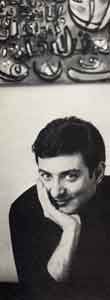 Issam El-Said held numerous solo-exhibitions in the Middle East, Europe and the USA and participated in various group exhibitions including: 1983 Contemporary Arab Artists III, Iraqi Cultural Centre, London . 1982 Contemporary Arab Graphics, Graffiti Gallery, London . 1980 Third World Biennial of Graphic Art, Iraqi Culture Centre, London; Influence of Calligraphy on Contemporary Arab Art, Iraqi Cultural Centre, London . 1977 Victoria and Albert Museum, London; Christies Contemporary Art, London . 1969 Sultan Gallery (with Munira al-Kazi), Kuwait . 1964 Galerie Dagmar Wirth (with Nuha al-Radi), Berlin, Germany; Litchfield Gallery, New York, USA . 1963 Galerie Dagmar Wirth, Berlin, Germany . 1963 and 1962 Woodstock Gallery, London; Arab Artists Group; Banouch Gallery, Bahrain
Issam El-Said held numerous solo-exhibitions in the Middle East, Europe and the USA and participated in various group exhibitions including: 1983 Contemporary Arab Artists III, Iraqi Cultural Centre, London . 1982 Contemporary Arab Graphics, Graffiti Gallery, London . 1980 Third World Biennial of Graphic Art, Iraqi Culture Centre, London; Influence of Calligraphy on Contemporary Arab Art, Iraqi Cultural Centre, London . 1977 Victoria and Albert Museum, London; Christies Contemporary Art, London . 1969 Sultan Gallery (with Munira al-Kazi), Kuwait . 1964 Galerie Dagmar Wirth (with Nuha al-Radi), Berlin, Germany; Litchfield Gallery, New York, USA . 1963 Galerie Dagmar Wirth, Berlin, Germany . 1963 and 1962 Woodstock Gallery, London; Arab Artists Group; Banouch Gallery, Bahrain

A limited number of copies of the following books are available for purchase. Please Contact Us for further details.
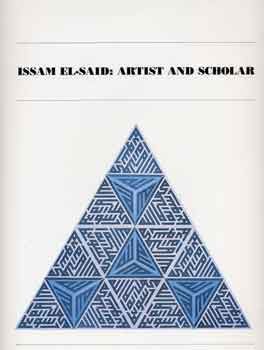 Issam El-Said: Artist and Scholar
Issam El-Said: Artist and Scholar
Published by Issam El-Said Foundation, 1989
ISBN 0951541706
Book Dimensions: 30.5x29cm
Art directed and designed by Samir Chorbachi
Price: £45.00 UKP plus postage & package
In both English and Arabic. Containing over a hundred colour plates illustrating El-Said's work, including many of his own paintings and drawings, and with written contributions from members of his family and colleagues in the art world, this book is a celebration of Issam El-Said's life and art.
Front cover (English)
 Issam El-Said: Artist and Scholar
Issam El-Said: Artist and Scholar
Back cover (Arabic)
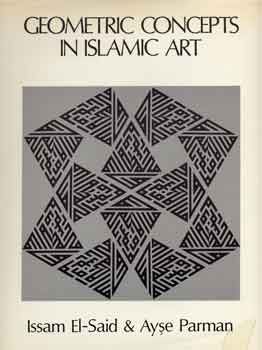 Geometric Concepts in Islamic Art
Geometric Concepts in Islamic Art
Issam El-Said & Ayse Parman
Published by the World of Islam Festival Trust, 1976
ISBN 0905035038
Book Dimensions: 30.5x25cm
Price: £50.00 UKP plus postage & package
This study traces man's approach to measurement, outlines the geometric concepts of design and shows how they apply to different fields of Islamic art.
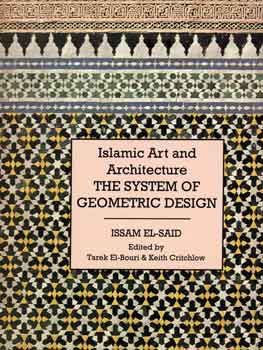 Islamic Art and Architecture: The System of Geometric Design
Islamic Art and Architecture: The System of Geometric Design
Issam El-Said
Edited by Tarek El-Bouri & Keith Critchlow
Published by Garnet Publishing Limited, 1993
ISBN 1873938454
Book Dimensions: 35x25cm
Price: £50.00 UKP plus postage & package
The distinct character of Islamic art has been sustained throughout centuries & across diverse eras, regions & cultures, by geometric concepts of composition. In this book, Issam El-Said pinpoints the rules of composition that form the basis of this unity & shows how intricate patterns are based on these principles, rather than complex trigonometry & formulae. Chapter I presents graphical analyses of numerous complex patterns, to reveal the numerical rationale behind them. In Chapter II, the author analyses the system of measure used in Ancient Egypt, before the use of numbers for calculating measurements. He shows how measuring cords & a geometric method based on a grid-pattern originating from the circle were employed by master craftsmen in the design of Islamic art & architecture. Overall, the book offers an insight into how craftsmen & designers in the Muslim world have achieved monumental feats of artistic expression with harmony & precision, using the simplest of tools such as a ruler & string & templates, together with a system of measure that is both simple & sophisticated, & as such embodies perhaps the true essence of beauty.
The displayed text/artwork (or variations of it) is featured in the book Issam El-Said: Artist and Scholar. To purchase the book or any of the artworks illustrated in this website (unless otherwise indicated) please contact us.
© ayagallery 2002-15 . All rights reserved
You are visitor number